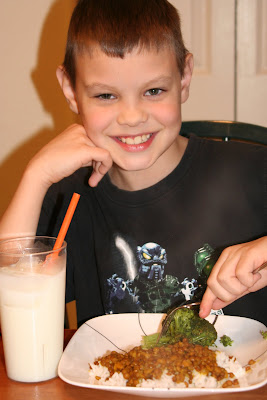
I don't have a picture of the recipe I'm sharing today, so I thought I'd start my post with this photo that I took at Waldumar Nature Center toward the end of the summer, when my younger son was attending day camp there. I'm not sure why, but black-eyed susans seem to have been incredibly prolific around here this year! And purple coneflowers are one of my favorite perennials. By the way, notice the extended depth of field in this photo. The flowers are in acceptable focus pretty much from the front of the image to the back. That's not always what I want when I'm shooting flowers. In fact, more typically, I like to focus closely on one individual flower and "blur out" the other flowers and scenery behind the subject flower. But for a whole garden of beautiful blooms, there's nothing like capturing the image with an extended depth of field. In this case, I used a fairly narrow 8.0 aperture to achieve the look that I wanted. I'll talk more about depth of field and how to manipulate it in a future post.
So, this post is about an easy way to save a few dimes. These days, who isn't looking for simple money saving ideas? I'll preface the recipe by saying that sometime last winter, I started eating oatmeal every morning for breakfast. I'd only recently started eating breakfast at all, and I'd typically bring a yogurt in to my office and eat it at my desk. But once the weather turned cold, oatmeal was much more appealing. I started bringing in envelopes of instant oatmeal in my favorite flavor, brown sugar and cinnamon, and cooking them in the office microwave. At the time, my teenage son was also on an oatmeal kick and, being a still-growing young man, he would usually eat two envelopes of oatmeal each morning. Accordingly, I started buying the industrial sized box of instant oatmeal at Sam's Club, which was a pretty good value.
And then a friend of mine asked if I knew of any cake-in-a-mug or brownie-in-a-mug recipes. She was making up some "comforts of home" type gifts for a few college students who lived in the dorm and who would have access to nothing more than a microwave for cooking. Well, in the process of searching for cake and brownie recipes for her, I ran across a number of websites with recipes for all kinds of dry mixes and convenience foods that you'd typically buy in the grocery store for a lot more money. Things like taco seasoning and onion soup mix. One of the recipes that immediately jumped out at me was homemade instant oatmeal mix. Looking at the simple list of ingredients, I couldn't believe that it had never occurred to me to make my own oatmeal mix instead of buying the pre-portioned envelopes. Since my favorite flavor of oatmeal was brown sugar and cinnamon, I tinkered with the basic recipe on the website a bit until I came up with a spice blend that I liked. I've never looked back. These days, I mix up a big container of this oatmeal mix and keep it right in a drawer in my office. I'm never without a healthy breakfast or a quick snack, for a fraction of the cost of the envelopes of instant oatmeal that I'd been buying.
Homemade Instant Brown Sugar and Spice Oatmeal Mix
5 cups quick oats (NOT old-fashioned oats)
4 Tblsp. brown sugar
3 Tblsp. dry milk powder
1/4 tsp. salt
2 tsp. cinnamon
1 tsp. nutmeg
1/4 tsp. gound cloves
Small Ziploc bags (optional)
In large bowl, combine all ingredients. Transfer to an airtight container until ready to use, or portion into Ziploc bags for single servings (use 1/2 cup mixture per bag). To serve: Place 1/2 cup of oatmeal mixture into bowl; add about 1/2 cup (or more, depending on how thick you like your oatmeal) boiling water. Let stand until thickened. For microwave: Place 1/2 cup oatmeal mixture into a microwave safe mug or bowl. Add about 1/2 cup water and microwave on high for one minute. Note: I love raisins or other dried fruit in my oatmeal. I usually add a tablespoon or two of raisins, dried cranberries, or mixed dried fruit to my mug right after I take it from the microwave. Then I let the oatmeal sit for just a minute, which softens the fruit. If you're using the boiling water method, put the raisins in the bowl with the dry oatmeal mix, then add the boiling water.
With fall officially here, an oatmeal recipe seemed appropriate. I'm planning to post a pumpkin bread recipe in the near future, too, so be on the lookout for it!







